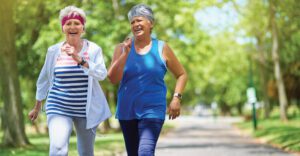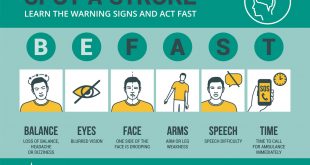

When you walk, your leg muscles require more oxygen from the blood than when sitting or standing. The arteries of someone with PAD, are narrowed by plaque build up from cholesterol and other substances, which prevents the delivery of this additional oxygen. The most common symptom of PAD is pain or discomfort in the leg, which can be cramping, aching, or fatigue while walking. Claudication can be reduced by following a program of regular walking, which allows the leg muscles to use oxygen more effectively and thereby reducing symptoms.
Why is walking important?
Regular walking to the point of developing moderate pain, then resting briefly, and repeating this process, will improve your ability to walk more than any other known exercise and most other medical and surgical treatments. If you have PAD, a structured walking program can make a big difference, enabling you to double or triple the distance you can walk before developing symptoms or before having to stop. Not only is walking one of the best exercises, but it is also the simplest and least expensive. Walking can be done at any age and requires no special talent or equipment except good walking shoes.
What type of walking program is best for PAD?
There are two types of walking programs: a supervised program, and a home-based program. Supervised walking programs are often found in a cardiac rehab, clinical exercise center, medical fitness center, hospital, or vascular surgery practice, and are generally available at a modest fee. Some may be covered by your insurance plan. Usually, these programs last 3 to 6 months and include 3 or more walking sessions per week with supervision by nursing and medical specialists. Research findings from these programs show improved walking ability in almost all patients. A regular walking program not only improves walking ability but also is likely to produce benefits that reduce the risk of heart disease and stroke.
Among these benefits are lowered blood pressure, lower cholesterol, and weight loss in conjunction with a healthy diet. The Vascular Disease Foundation encourages participation in supervised walking programs for people with PAD to reduce symptoms of claudication, and the risk of heart disease, and stroke.
Your Walking Program Step by Step
Warm Up
As with any exercise, it is good to warm up before you start. Begin with very slow and easy walking, or easy stretching of the muscles of the thighs and calves.
Walk
Begin walking and increase the pace until you reach a moderate level of pain. Unlike most advice to stop when you feel pain in other parts of the body, walking until you experience moderate pain in the legs stimulates improvement in people with leg symptoms due to PAD. Try to walk at a pace that causes some pain in three to five minutes.
Stop and Rest
Stop walking after you reach a pain level of mild to moderate pain. Rest until the pain is gone. It may take several minutes. Please note that chest pain or shortness of breath should be by discussed with your health care provider.
Repeat the Walk/Stop Steps
After the pain is gone, repeat the walk/stop sequence several times. The goal is to try to build up to 50 minutes, at first you might be able to achieve only 10 to 20 minutes. Soon you will find that you can walk faster and longer with less pain. If you are walking outdoors wear the right clothing for the temperature and protect yourself from the sun, also drink plenty of water.
Sarasota Vein Center
941-371-6565
www.veinsandarteries.com
Sarasota
600 N. Cattlemen Road, Sarasota, Florida 34232
 Southwest Florida's Health and Wellness Magazine Health and Wellness Articles
Southwest Florida's Health and Wellness Magazine Health and Wellness Articles

